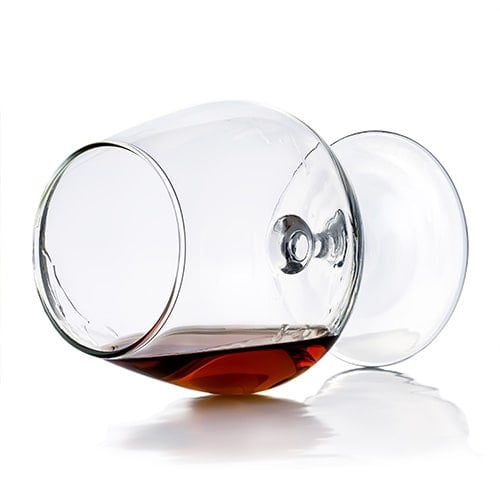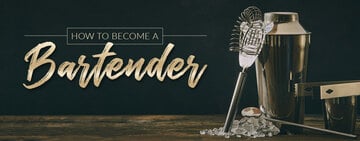Part of running a successful bar is keeping your liquor shelf well stocked with a wide selection of beverage options for any occasion. Brandy is a sophisticated liquor that is perfect for any bar, pub, or hotel lounge. Below, we’ll show you how to properly serve and drink brandy so you can make a good impression on your customers and boost your sales.
Shop All Brandy GlassesWhat Is Brandy?
Brandy is a hard liquor made from distilled, barrel-aged fruit wine. Brandy is typically made from fermented grapes but other fruits, like peaches, apples, blackberries, and pears can be used to create unique flavor profiles. Brandy can be served directly after the distilling process for mixed drinks or aged in wooden barrels for a richer color and more complex flavor to be enjoyed straight. The word “brandy” comes from the Dutch word “brandewijn” meaning “burnt wine”. It is often used to make fortified wine.
How to Drink Brandy
There are three distinct ways to drink brandy that impact how it is served and enjoyed.
- Neat - Drinking brandy neat means that it is enjoyed straight, without ice or any additional mixers.
- On the Rocks - Drinking brandy on the rocks means that the liquor is served with ice.
- In Cocktails - Brandy can be paired with mixers and syrups to create a variety of brandy cocktails.
It is important to consider all three brandy drink styles when setting drink prices in your bar or restaurant. Be sure to ask your customers’ preference if they do not specify, as each person may have their own opinion on the best way to drink brandy.
How to Serve Brandy
Watch our video tutorial to learn the easiest way to serve brandy.
Best Way to Serve Brandy
Serving brandy to your customers is not just about pouring liquor into a glass. This intricate spirit calls for the same showmanship in the serving process as it does in the drinking process. Use the following steps to properly serve brandy in your bar:
- Pour immediately. Although brandy is made from fruit wines, it does not need to breathe before serving. Brandy can be poured immediately after the bottle is opened.
- Choose the right brandy glass. Brandy should be served in brandy snifters (also known as a brandy inhaler) to provide the optimal drinking experience. The wide bowl allows the customer to swirl and warm the liquid in the glass, while the tapered opening directs the aromas to the customer's nose and intensifies the flavors in the brandy.
- Fill glass at an angle. Turn the brandy snifter horizontally and pour the brandy into the bowl until the liquid touches the rim. Pouring your brandy at an angle not only provides an eye-catching presentation to impress your customers, but it also provides you with an even pour every time. From the bottom of the bowl to the rim, a 9 oz. snifter glass will measure out a 1.5 oz. portion when held horizontally.
- Serve your customer. Once the shot is poured, place the brandy glass in the palm of your customer's hand so their palm can begin warming the brandy.

How to Drink Brandy Straight

Most high-quality aged brandies are recommended to be enjoyed straight. When drinking brandy neat, there is a process you and your customers can follow to get the most out of the experience, similar to how you would taste whiskey.
- Warm the glass in your palm. The heat from your hand will open up the molecules in the liquor and release the aromas in the drink. Some brandy connoisseurs may even heat the brandy over an open flame to speed up this process. You can warm the glass with warm water before serving. However, it's important to dry the glass before pouring the brandy or else the water droplets can change the flavor profile of the liquor.
- Swirl the liquid. By moving the liquid in the glass, you can warm it more evenly and open up the bouquet of aromas.
- Observe the color. The longer a brandy ages in a barrel, the darker the color will become and the richer the flavor.
- Hold the glass at chest height. Smell the brandy through your nose at this distance to see what subtle aromas you can get initially.
- Hold the glass at chin height. Smell the brandy through your nose at this closer distance to catch more of the complexities in the aroma of the brandy. You’ll most likely smell the fruit in the brandy at this point.
- Raise the glass to your nose. With the glass at your nose, take a breath in first through your nose then through your mouth to catch the aromas of spices and fruits in the brandy.
- Take a small sip. The first sip of your brandy should be a very small one, enough to wet your lips so that the alcohol doesn’t overwhelm your taste buds.
- Take larger sips. The next few sips should slowly increase in size as your taste buds acclimate to the flavor and explore the intricacies of the brandy.
- Add a drop of water (optional). Once you have appreciated the brandy’s natural flavor, you can add a few drops of water to mellow out the alcohol content and see if other flavors in the brandy become more notable.
Impress your customers and encourage repeat orders by guiding them through this brandy drinking ritual.
How to Drink Brandy with Ice
Although some may consider it offensive to add ice to a brandy, others find it to be the perfect touch depending on the brandy’s age and flavor. A brandy that has been aged 2 to 6 years may benefit the most from this drinking method. Use the following tips if you plan to sip your brandy on the rocks or serve it chilled to your customer.
- Try it Neat. Before you add ice to a brandy, become familiar with what it tastes like on its own. Follow the process of warming, swirling, observing, and smelling the brandy so that you can compare the flavor differences between drinking it straight to drinking it chilled. If your customer orders brandy on the rocks, allow them to sample the brandy straight before chilling it for them.
- Use a large single cube. Instead of adding various small cubes that may water down the brandy, use a silicone ice mold to create large cubes that will evenly chill the brandy without melting too quickly.
- Let it cool. If the brandy is consumed immediately after the ice cube is added, it will not have enough time to chill thoroughly and may still carry that potent alcohol flavor.
- Sip slowly. Brandy should be enjoyed slowly to allow time for the taste buds to acclimate to the flavor and fully enjoy its complexities.
Types of Brandy

Now that you’re familiar with the proper brandy drinking method, it is time to explore the different types of brandy available to you for your to stock your bar shelves.
- Cognac - Cognac is a brandy that is strictly made in the Cognac region of France. It consists of only three types of grapes that are specifically grown in that region. Cognac is then distilled twice and aged for at least 2 years to bring out its rich fruity and oaky flavors.
- Armagnac - Armagnac sources its grapes from and is produced in the Armagnac region of France. Armagnac features a fruity taste with hints of toffee, and it usually has a higher alcohol content than Cognac.
- Brandy de Jerez - Brandy de Jerez is made in the Jerez region of Spain and matured in sherry casks using the solera system (a blending process that mixes a type of liquid with varying aged versions of the same liquid). It is usually distilled from grapes but can be made with cherries, peaches, or apples. Being aged in sherry casks, it takes on a red hue and full-bodied flavor.
- Calvados - Calvados is an apple brandy produced in the Calvados department in Normandy, France. It is a distilled apple cider that is aged in oak casks for at least two years.
- Pisco - Pisco is a Peruvian brandy made from fermented grape juice. It uses grapes grown in Peru and Chile’s wine country. It is typically light yellow to amber in color and features a high alcohol content.
- Fruit Brandy - Fruit brandies are named after the main fruit used to make them and can be served relatively young in age. Some of the most common fruit brandies include peach brandy, apple brandy, pear brandy, and cherry brandy.
Brandy Ages
After categorizing brandy by type, it is then sorted by ages. Young brandy is usually used for cocktails, while older brandies are generally enjoyed straight. An older brandy will have a darker color and it will take on more the flavor of the aging barrel. Below are acronyms a brandy bottle may bear to indicate its age:
- A.C. - Aged 2 years in wooden barrel (excluded from Cognac labels, since Cognac’s minimum age is 2 years)
- V.S. - “Very Special” or “3-star Brandy”; Aged at least 3 years in wooden barrel
- V.S.O.P. - “Very Special Old Pale” or “5-star Brandy”; Aged at least 5 years in wooden barrel
- X.O. - “Extra Old”; Aged at least 6 years in wooden barrel
- Vintage - Stored in wooden barrel until bottled, bottle must then reflect the bottling date, most common with Armagnacs
- Hors d’Age - “Of the Ages”; considered too old to determine the age, usually at least 30 years old, typically reserved for Cognacs
Use this brandy alphabet on your drink menu to help your customers choose the best brandy for their taste preferences.
Brandy Cocktails

Younger brandies can be paired with a variety of cocktail mixes to create a versatile drink menu for your bar. Most brandy cocktails are made with a brandy that is aged 3 years or less. Here are some brandy mixed drinks to consider:
- Brandy Sour: Cognac, lemon juice, sugar syrup, bitters, and pasteurized egg whites
- Brandy Highball: Cognac, ginger syrup, and sparkling fruit juice
- Brandy Sidecar: Cognac, triple sec, and lemon juice
- Metropolitan Brandy: Brandy, sweet vermouth, simple syrup, and bitters
- Sangria: Dry wine, brandy, orange juice, fruit, and sugar
Whether you’re just opening a new bar or looking to shake up your liquor menu, brandy is an excellent spirit with a variety of types and age options for you to choose from. Boost your bar’s appeal by offering brandy tastings and impress your new customers by demonstrating the right way to drink brandy.








